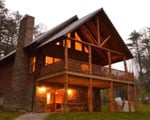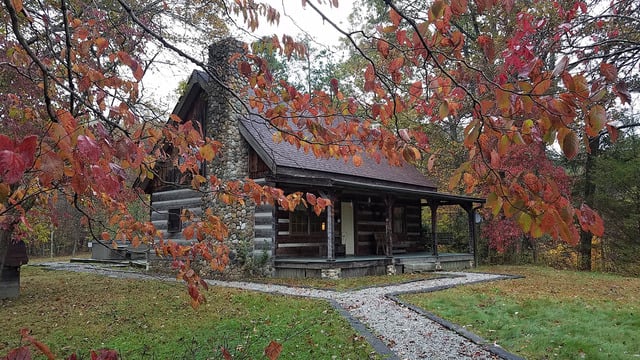JACKSON LAKE STATE PARK
Although relatively small, Jackson Lake State Park boasts acres of some of the most scenic country in Ohio. The park's serene lake is a focal point for excellent fishing and provides the ideal setting for a peaceful retreat.
Jackson Lake lies nestled in the heart of the unglaciated hill country of southeastern Ohio. These sandstone hills are part of the Appalachian Highlands known for their diversity of plant and animal life. This region of Ohio is heavily forested; nearly 70% of the state's woodlands are contained in these highlands. However, at one time most of the land was barren, having been extensively logged to fuel the iron smelting industry that once flourished here. Today, the land has recovered and supports a magnificent second-growth forest containing oak, maple, hickory, tulip tree and others.
The park is home to a variety of animals including white-tailed deer and wild turkey. Other residents are skunks, raccoons, opossums, numerous songbirds, gray squirrels, great horned owls and many reptiles and amphibians. The park's varying habitats support beautiful displays of wildflowers spring through autumn including spring beauties, dame's violet, goldenrod and asters.
Rugged hills and mist-filled valleys provide a colorful backdrop for Jackson Lake State Park. Two miles west of the town of Oak Hill, Jackson Lake is situated in one of the most picturesque regions of the state. The Jackson Lake area, in addition to its outstanding natural features, is endowed with a rich cultural history that spans many centuries.
Prehistoric Indians occupied the vast wilderness north of the Ohio River, as evidenced by numerous relics discovered in the southern Ohio area. Among these relics are impressive burial and ceremonial mounds and mysterious carvings in the sandstone rock of the region. These carvings, called petroglyphs, are symbolic representations of the Indian's life. The Leo Petroglyph near the park has been carefully preserved by the Ohio Historical Society.
Thousands of years later, the densely forested upper Ohio Valley was ntermittently populated by more recent Indian tribes. Mingos, Delawares and Shawnees all made a home there. As pioneer settlers moved westward into the wilderness, the Indians were gradually displaced to the western plains. Using the abundant resources of forest and land, the new Ohio immigrants built farms, towns and cities and began development of several industries.
In the autumn of 1854, the hills of Jefferson Township were awakened by the sound of a whistle from a new industry that was to attract nationwide attention to the Hanging Rock Iron Region of southeastern Ohio. Buried below the land's surface lay vast stores of iron ore. Discovery of this valuable material initiated the development of a world-renowned iron industry. The Jefferson Iron Furnace was constructed to help meet the demand for iron products in the eastern United States. During the Civil War, the Jefferson Iron Furnace and other foundries in the Hanging Rock area became crucial to the operation of the Union Army--being used to manufacture cannons.
In a short time, "Jefferson iron" became the standard of excellence throughout the Hanging Rock region and the world. Sold to manufacturers under the trade name "Anchor," this iron was used to build the ironclad warship, the Monitor. History books vividly recall the famous naval battle of the two iron-clad ships, the Monitor and the Merrimack.
Just a few short decades after the Civil War came to an end, richer lodes of iron ore were found elsewhere in the United States. As the growing nation demonstrated a need for iron ore in greater quantities than the Hanging Rock region could produce, the great furnaces of the southeastern Ohio hills shut down. The Jefferson Iron Furnace made its last cast in 1916. Today, visitors may explore remnants of the furnace within the park boundaries. Coal mining was very profitable in the Jackson Lake region. In 1888, over a million tons of high quality coal were mined here. Jackson County was second only to Perry County in coal production in Ohio.
Great salt mines were located along Salt Creek. This salt was thought to be so important to the country that a six-mile tract was set aside by Congress for the use of the state to secure the salt. Prior to settlement, Indians came here from great distances to extract the salt.
During the heyday of the Hanging Rock furnaces, the lush woodlands of the hill country were cut to make charcoal to fuel the furnaces. As the furnaces began to decline, the forests rejuvenated and the area became increasingly attractive as a recreational region.
In 1938, Jackson Lake was impounded and the area was operated by the predecessor of the Department of Natural Resources. Over the years, a small camping area and swimming beach were added. These facilities were improved and picnic areas were added in the mid-1970s. Jackson Park was dedicated as a state park in 1979.
Ohio does not have an annual pass and does not charge entrance fees to state parks.
GeneralLand, acres107
Water, acres242
Nearby Wildlife Area, acres2,000
Day-UseFishingyes
Picnickingyes
Picnic Shelters, #3
Swimming Beach, feet200
BoatingBoating Limits10
Launch Ramps, #2
CampingElectric Sites, #34
Pets Permittedyes
Dumpstationyes
WinterSleddingyes
Ice Skatingyes
Ice Fishingyes
A small campground with 34 electric sites has open sites close to the beach. Campers with pets are permitted in designated areas. A Rent-A-Tepee site is available for reservation. Contact the park office for details.




